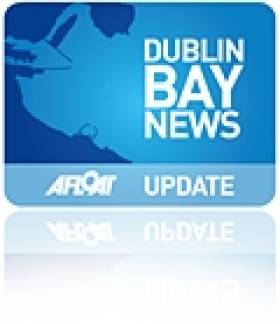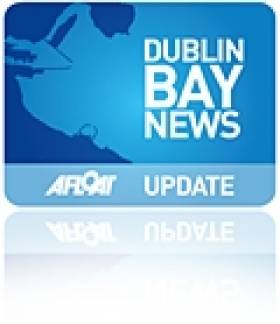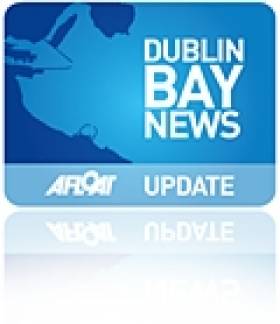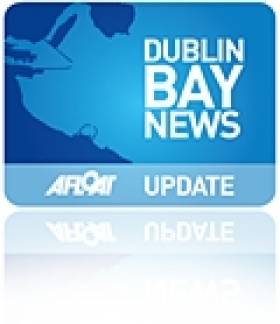Displaying items by tag: Dublin Bay News
#ConferenceKetch – The Irish Whale & Dolphin Group's ketch, Celtic Mist previously owned by former Taoiseach Charles Haughey is to call to Dublin quays tomorrow as part of the Dublin Bay Conference, writes Jehan Ashmore.
Three hundred years ago this week,Dublin City Assembly decided to build an embankment (Great South Wall) from Ringsend into Dublin Bay as previously reported on Afloat.ie, in an effort to solve the centuries-old problem of silting in the main channels into Dublin Port.
The one-day conference will have a host of lecturers lined up to celebrate the construction of the marine engineering feat which when completed was then the world's longest sea wall as it jutted out into central Dublin Bay.
The guest speakers will also be focusing on many current topical issues about Dublin Bay, notably the subject, "Dublin Bay: History and Environment" which has been chosen because of the recent Environmental Impact Statement for the Redevelopment of Alexandra Basin.
The proposed project is so to accommodate larger cargoships and a €30m cruise terminal for massive cruiseships of the next generation to dock closer to the Dublin 'Dockland's and city-centre.
The EIS has involved the collection of a large amount of new information on Dublin Bay in which the Dublin Port Company want to share such information with a wider audience in which tickets for the conference have since been sold out.
An opportunity however presents the public to board the 56ft steel hulled ketch Celtic Mist, which was donated by the Haughey family to the group in 2011, when she is berthed alongside the North Wall Quay.
Those visiting will learn about work carried out by the IWDG which was gifted the ketch in recognition of their work over the past 23 years. The group will explain about cetaceans and the rich marine life in Ireland and in the promotion of marine conservation.
Celtic Mist is equipped with acoustic marine monitoring equipment to enable IWDG scientists, students and members to learn more about the distribution, abundance, movements and behaviour of whales, dolphins, porpoises and basking sharks. For further details visit www.celticmist.info/
#HSStoCruiseScene - Had Stena Line retained running HSS Stena Explorer this year on the Dun Laoghaire-Holyhead route, this would have been her 20th year and with sailings scheduled to have begun last week, writes Jehan Ashmore.
However, the final chapter for Stena Line on this historic Ireland-Wales route came to an end with the official announcement in February to close the Dun Laoghaire-Holyhead route permanently in 2015 as previously reported on Afloat.ie.
The development saw the historic 170 year route cease having its origins dating to 1835. Stena instead concentrated all operations on its other Dublin Bay service using those from Dublin Port on the existing route to Holyhead.
For more on the end of the Dun Laoghaire ferry-era, a photo of the HSS Stena Explorer (published in Ships Monthly) as she departs Dun Laoghaire Harbour for the final time on the 9th September with the return leg to Holyhead.
HSS Stena Explorer made her debut in 1999 as the first of a trio of 1500 series. The revolutionary catamaran car and vehicle carrying fast-ferry craft directly replacement the last conventional ferry on the route, the Stena Adventurer. Not to be confused with the current Stena Adventurer serving the Dublin Port-Holyhead route and joined earlier this month by Stena Superfast X.
Notably, no other vessel except the HSS Stena Explorer can use the custom built linkspan structures that lay idle in Dun Laoghaire Harbour and Holyhead Port, as the HSS was exclusively guided to these specialist structures using satellite positioning technology. Remarkably, this did not requiring berthing in the traditional way, as 'arms' clamped the stern without the need for ropes, dockers and related fees.
So what beckons the future ferry service? as previously reported on Afloat.ie, the invitation from Dun Laoghaire Harbour Company for a new ferry operator to run a seasonal-only service resulted in seven interested parties. According to DLHC, a berth has been made available and should a service resume, it would not be until 2016.
Further updates on this development will be made on 'Ferry News', noting the new dynamics following yesterday's launch by the Dun Laoghaire Harbour Company's Public Consultation Process over the proposed €18m cruise ship jetty and associated berth quay facility.
For full details of the proposals and the public consulation process visit: http://dlharbour.ie/projects/cruise-berth-consultation/
The proposed port infrastructure at Dun Laoghaire would jut out into the harbour beyond the marina's eastern breakwater that adjoins the former Stena HSS berth linkspan.
While across Dublin Bay, a €30m cruise terminal is also proposed in Dublin Port but closer to the capital 'Docklands' at the East-Link Bridge. Both proposed facilities would be capable of handling the world's largest cruiseships.
Dun Laoghaire Town Vows to Survive Ferry Blow
#DunLaoghaireBID – The Dublin People writes that the Dún Laoghaire business community, will not be affected by Stena Line's recent decision to end seasonal ferry services from the town to Holyhead, a local group has insisted.
Despite widespread expressions of concern for the future of the town's economy following the announcement, the Dún Laoghaire Business Improvement District (BID) company said it expects no negative impact on the local business community.
The BID company said the Stena move will not affect retailers as Dún Laoghaire Harbour has been designated as a marine and leisure destination by the Dún Laoghaire Harbour Company Master plan and the National Ports Policy.
The BID focus on attracting leisure visitors, especially from the cruise industry, will be realised with over 100,000 cruise passengers set to arrive in Dún Laoghaire this summer, following an intense international marketing campaign by the Dún Laoghaire Cruise Stakeholders group, of which the BID Company is a member.
To read much more on this story, click HERE.
As previously reported on Afloat.ie, the Dun Laoghaire Harbour Company Ltd (DLHC) are seeking expressions from other providers to operate a seasonal ferry service on the Dun Laoghaire to Holyhead route.
For further details, click for advert HERE.
Afloat adds that according to the DLHC should a new operator be found such a service would not begin until 2016.
No Wrecks Found in Search of Dun Laoghaire Harbour Form Part of Related Planning Process of Proposed New Cruise Berth
#WreckSurvey- Survey work for possible wrecks within Dun Laoghaire Harbour as previously reported, have the port company confirmed are related to the preparation of a planning application to An Bord Pleanala for a proposed new cruise pier berth, writes Jehan Ashmore.
In order to handle the 'next generation' of considerably larger capacity cruise ships with deeper drafts to dock inside the harbour at the proposed €15m cruise berth jetty would require dredging in the harbour channel. Any wrecks found that are deemed of archaeological significance must be made known before a dredging license can be granted.
It transpires no wrecks were found inside the harbour following searches by Geological Survey of Ireland (GSI) catamaran RV Keary which carried out an EIS on behalf of Dun Laoghaire Harbour Company. The works included some timbers located under a rock outside along the East Pier wall, though the timbers are long known about and were found by trainee divers many years ago.
Since the Dun Laoghaire Harbour reopened the cruise industry to the east-coast town in recent years after an absence of more than a decade, larger cruise ships still have to make anchorage calls offshore. Smaller cruise ships such as Serenissima berthed at Carlisle Pier which is opposite to the East Pier site of the 'Urban Beach Project' recently granted planning permission.
The proposed cruise berth jetty which would jut out from the Dun Laoghaire Marina's eastern breakwater and this would form an integral component of the harbour's 'masterplan' which is to develop new business in a port listed as one of five ports of regional significance.
Added to this is notably the future of the Stena Line service to Holyhead re-opening? in 2015 remains much in doubt. According to The Irish Times, should Stena Line pull operations from the port, sources estimated the move could cost the harbour company €7 million in lost revenue.
The harbour company plans to expand the cruise ship sector for 2015, in which next year's season as previously reported is to generate a record total of cruise passengers to the harbour and neighbouring Dublin Port.
GSI Investigates: Suspected Buried Timber Wreck Within Dun Laoghaire Harbour
#SuspectedWrecks – According to the Geological Survey of Ireland (GSI) they suspect a buried timber wreck lies close to the entrance of Dun Laoghaire Harbour, writes Jehan Ashmore.
In recent days the GSI's South African built research vessel RV Keary, named after Raymond Keary, one of Ireland's pioneering marine geologists, has been carrying out site investigations assisted by her tender boat.
The underwater work is also according to another source understood to be associated with the proposed cruise line pier. As part of these works divers over the next few days are to assess the archaeological significance (or otherwise) of up to two wrecks located within the harbour before a dredging licence can be granted.
On this occasion divers are to use an underwater vacuum system to suck the silt away from the wreck to discover what condition it's in.
One wreck is close to the East Pier Lighthouse and the other is in the centre of the shipping channel as shown in the photo above taken yesterday. The vessel is seen with a flag aloft her mast which denotes diving operations are underway.
The asymmetrical catamaran hull which is grey in colour having been constructed of marine grade aluminium, instead seemed to appear almost white due to the strong winter sunshine.
Designed by Nic De Waal of Teknicraft in New Zealand, RV Keary's specific design brief was to a nearshore, shallow water survey platform. The stout-looking craft was manufactured by Veecraft Marine of Capetown and completed in 2008.
She was transported by cargoship to northern Europe from where she continued her delivery voyage which took several days to include bunker calls en route along the UK south coast.
As she made passage along the Leinster seaboard she transited Dalkey Sound before finally reaching her homeport of Dun Laoghaire.
In recent years RV Keary has been joined by a smaller inshore RIB, RV Geo and the chartered Central Fisheries Board Cosantoir Bradan, a patrol squadron cutter.
RV Keary's fleetmates were also at the time in the harbour but berthed in the marina.
#FundraiserDutchChoir - As part of on-going fundraising efforts for the National Maritime Museum of Ireland in Dun Laoghaire, the Dutch Stuyvesant Sailors Wolvega Male Voice Choir are to perform this Friday at 7.30 pm.
The choir will bring a mix of intriguing and light hearted Dutch and English language Sea Shanties and Folk Songs to delight all tastes. This much travelled choir is sure to bring pleasure when the performance starts half an later at 8pm.
Tickets cost €10 and payable at the door or booked by email :[email protected] or by telephone (01) 2143 964
The Maritime Institute of Ireland's museum is located on Haigh Terrace. A new landmark near the museum (former Mariner's Church) is the new central library and cultural centre, the Lexicon.
For further details in general about the NMMI visit: www.mariner.ie
Dun Laoghaire's First Cultural Night Includes Maritime Museum & Lecture
#CulturalNight – The National Maritime Museum will be open to the public free of charge this Friday 19 September (between 5-6:30 pm) as part of Dun Laoghaire Rathdown County Council's first participation of the nation's annual Cultural Night.
During the same evening starting at 7.00pm there will be another free event (also in the museum) of a lecture on 'The Nature of the Irish Sea Coast' presented by environmental consultant Richard Nairn.
The lecture forms the opening of the symposium The Irish Sea History, Cultural & Environmnet (as previously reported) which continues on the following Saturday, though an admission of €10 is charged at the door for the day-long event.
The Irish Sea Symposium is sponsored by the UCD Earth Institute, UCD Humanities Institute and the Atlantic Archipelagos Research Consortium.
Following the symposium, there will be an optional €30 dinner (also payable at registration) held in the National Yacht Club, which involves a short walk to the venue along the harbour waterfront. In doing walkers will pass DLRCC's new albeit controvesial central library and cultural centre, dlr LexIcon which too will be open to the public for Cultural Night.
Information updates and to register for the symposium email [email protected] or visit Irish Sea Symposium website here.
For other DLRCC organised Cultural Night free activities and events (click HERE) will be held throughout the borough.
Howth Service Revived In Advance of Holyhead Seasonal Route Closure
#DublinBay- Two commercial operators using Dun Laoghaire Harbour have opened and closed services a day apart, writes Jehan Ashmore.
As previously reported, Stena Line's HSS fast-craft that operates the Dun Laoghaire-Holyhead seasonal-only service ceased sailings today. Stena Explorer will however resume sailings for a short period over the Christmas and New Year periods.
Last Sunday, Dublin Bay Cruises revived the direct Dun Laoghaire-Howth Harbour cruise which Afloat reported last year when the operator first launched their inaugural season.
Back by popular demand the 90 minute excursion trip across Dublin Bay sees the 120 passenger St. Bridget serve this scenic route.
In total there are five cruise options that DBC have to offer in Dublin Bay involving calls in Dun Laoghaire, Howth and Dublin Port where St. Bridget berths along the city quays.
At weekends the operator runs an evening cruise departing Dun Laoghaire into Dublin Bay which includes a transit of Dalkey Sound leading into Killiney Bay.
All cruises will cease operating on 30 September. For information visit: www.dublinbaycruises.com or contact: (01) 9011757
Symposium’s Website: The Irish Sea - History, Culture & Environment
#PublicLectures – The Irish Sea: History, Culture & Environment is the title for a two-day (19-20 Sept) symposium as previously reported is to be hosted by the Maritime Institute in their premises of the National Maritime Museum of Ireland, Dun Laoghaire.
At this stage we can update by adding a website for the symposium (click HERE), giving further details, list of guest speakers and topics covering the sciences, humanities and maritime heritage. They ask the question "What does the Irish Sea contribute to the lives of the people who inhabit its shores?"
In addition to the NMMI hosting the event, organisers include the Earth Institute and Humanities Institute both from University College Dublin and the Atlantic Archipelagos Research Consortium.
A free public lecture in the Maritime Museum on 'The Nature of the Irish Sea Coast' will be held on Friday (19 Sept) at 7 pm by environmental consultant Richard Nairn.
In advance of that lecture the museum will also be open to the public free of charge from 5 pm until 6:30 pm as part of Dun Laoghaire Rathdown County Council's Cultural Night celebrations.
Entry on Saturday (20 Sept) will cost €10 for the day, payable on registration at the museum. There will also be an optional €30 dinner for participants in the National Yacht Club, Dun Laoghaire on Saturday night payable at registration.
To register attendence of the symposium,click again for their website HERE
For further information including that about the NMMI visit: www.mariner.ie
Symposium: The Irish Sea History, Culture & Environment
#IrishSeaHistory – Irish Sea History, Culture & Environment is the title for this two-day symposium held on 19-20 September.
The event is to be hosted by the Maritime Institute in their premises at the National Maritime Museum of Ireland, Dun Laoghaire.
The public symposium will bring together speakers from the sciences, humanities and maritime heritage to ask the question "What does the Irish Sea contribute to the lives of the people who inhabit its shores?"
In addition to the host, organisers include the Earth Institute and Humanities Institute both from University College Dublin and the Atlantic Archipelagos Research Consortium.
For further details contact by email to: [email protected]







































































